skip to main |
skip to sidebar
The Subtle Swiss Sense of Humor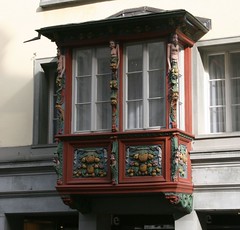 Sometimes it seems as if Swiss humor emerges most frequently in the architectural details of their buildings and public places. The brackets supporting the bay windows of the old buildings seems a particularly common place for small surprises and funny faces. One bay window in St. Gallen (left) was particular was loaded: funny faces and figures festooned all the brackets, the corner newels, and the panels. Elsewhere in town,dragons smiled from the end of each drain spout of otherwise dignified buildings.
Sometimes it seems as if Swiss humor emerges most frequently in the architectural details of their buildings and public places. The brackets supporting the bay windows of the old buildings seems a particularly common place for small surprises and funny faces. One bay window in St. Gallen (left) was particular was loaded: funny faces and figures festooned all the brackets, the corner newels, and the panels. Elsewhere in town,dragons smiled from the end of each drain spout of otherwise dignified buildings.
In Zurich, burghers, craftsman, pensioners, children and imps decorate the the Stadthaus building pillars. In Basel, a pool of small animated fountains bubble and purr with no reason but to cause a smile.
Walking home from the train station one afternoon last October, I just happened to glance at the shutter brackets on an old local building in Kilchberg. Crafted of black iron, and shaped like a hinged "L", the brackets sit at the bottom center of each shutter, holding them tight against the building when open. To my delight, each bracket was crafted so that a human face always pointed outward: a smiling face 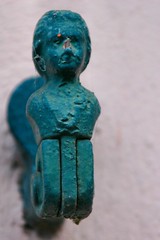 for an open shutter and a frowning one
for an open shutter and a frowning one 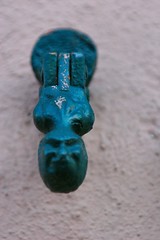 on the obverse for a closed shutter. While no bigger than 2 cm. across, each face, after decades of exposure, was still clear and detailed.
on the obverse for a closed shutter. While no bigger than 2 cm. across, each face, after decades of exposure, was still clear and detailed.
It seems, at least in the case of old swiss buildings, that joy lives in the details.
Continuing on my walk home and arriving at my 50s vintage flat, it seemed a pity that nearly all post WWII Swiss architecture is of the Bauhaus tradition: cold and angular and stark. While graceful, it seems lifeless and inhumane in comparison. Fortunately, a few squares of dark Swiss chocolate and dinner with a friend in an old inn can make up for an awful lot of bad architecture.
Salvias in Seattle - 2005 Version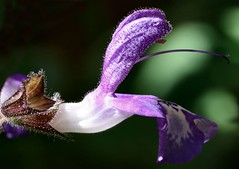 It's a cool, yucky, and gray day here in the Great Northwest with occasional showers. A storm of some size is due to blow in later this afternoon with lots of rain and some wind so I spent the morning and early afternoon in the garden doing autumn cleanup, including cutting back some of my Salvias planted in large pots. It's getting dark now so it's time to come inside, warm up, dry off, and write this year's edition of the Salvias in Seattle 2005 Review.
It's a cool, yucky, and gray day here in the Great Northwest with occasional showers. A storm of some size is due to blow in later this afternoon with lots of rain and some wind so I spent the morning and early afternoon in the garden doing autumn cleanup, including cutting back some of my Salvias planted in large pots. It's getting dark now so it's time to come inside, warm up, dry off, and write this year's edition of the Salvias in Seattle 2005 Review.
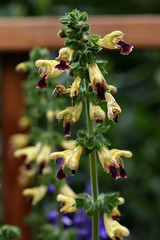 The early news this year was the blooming of the Asian Salvias, S. hians/forshkahlii(?) (on the left) and S. flava (on the right). Both of these plants put on big shows and were really spectacular. I do wish I could get some sort of definitive identification for the alleged hians plant - there seems to be considerable disagreement among the learned on the Yahoo Salvia List as well as in the nursery trade about which is being sold as what.
The early news this year was the blooming of the Asian Salvias, S. hians/forshkahlii(?) (on the left) and S. flava (on the right). Both of these plants put on big shows and were really spectacular. I do wish I could get some sort of definitive identification for the alleged hians plant - there seems to be considerable disagreement among the learned on the Yahoo Salvia List as well as in the nursery trade about which is being sold as what.
New this year were plantings of S. Greggii v. Furman's Red, S. Microphylla var. Variegata, S. Reptans, S. Elegans v. Honey Melon S. Chaemenoides, S. Nemerosa v. Marcus, S. Penstemoides, S. Greggii v. Navajo Yellow and S. Pitcherii v. Graindiflora. With the exception of S. Penstemoides, all bloomed at some point during the summer or fall. S. Reptans and S. Pitcherii both bloomed in late September / early October.
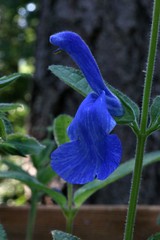 Old friends planted and blooming this year included S. Nemerosa, S. Patens, S. Guarantica v. Black and Blue, S. Farinaccea v. Victoria Blue, S. Officialis, S. Hot Lips, S. May Nights, and several varieties of S. Microphylla, S. Ulignosa, and S. Greggii. Oddly, one of my S. Patens plants produced variegated blosssoms (shown at left).
Old friends planted and blooming this year included S. Nemerosa, S. Patens, S. Guarantica v. Black and Blue, S. Farinaccea v. Victoria Blue, S. Officialis, S. Hot Lips, S. May Nights, and several varieties of S. Microphylla, S. Ulignosa, and S. Greggii. Oddly, one of my S. Patens plants produced variegated blosssoms (shown at left).
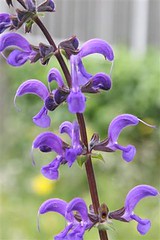 I also saw several other plantings of interest this year including humungous specimens of S. Leucantha and S. Ulignosa in full bloom in the cutting garden at Dig Nursery on Vashon Island.
I also saw several other plantings of interest this year including humungous specimens of S. Leucantha and S. Ulignosa in full bloom in the cutting garden at Dig Nursery on Vashon Island.
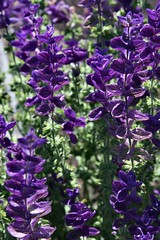 After seeing specimens of S. Viridis (left) at the St. Gallen Botanical Garden as well as at the Dig Cutting garden, I'll probably try to see how this grows here in the Cascade foothills next year.
After seeing specimens of S. Viridis (left) at the St. Gallen Botanical Garden as well as at the Dig Cutting garden, I'll probably try to see how this grows here in the Cascade foothills next year.
Another highlight was seeing a wild Swiss Salvia tentatively identified by Robin Middleton (Salvia Gardener par excellence) of the UK as S. Pratensis v. Hematodes (right). I found it blooming freely along roadsides for a few weeks at the end of May and early June. Though the blossoms were short lived they were exceptionally lovely with bright clear color.
A Long Time Quiet - St. GallenIt's been a while since I updated this online journal and for that I apologize. But not much; I've been doing lots of work with digital photography and participating on the Flickr community as well as traveling with work quite a lot.
September and October were fine months to be in Switzerland this year. There were few particularly dreary days and many fine days. As is usually the case at this time of year, the air was particularly clear and the Alps were showing their pre-snow faces.
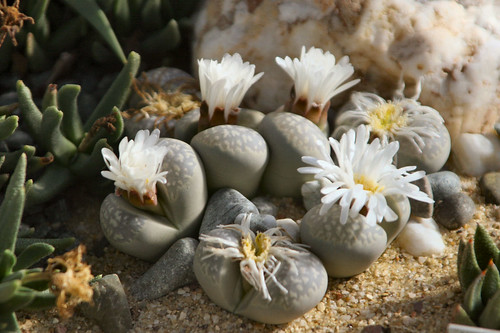 This trip was busy, work-wise, so I was unable to get away to do much touring on the weekends. I did spend a very delightful day in St. Gallen. As you can tell from my flickr pages, I spent an enjoyable morning in the Botanical Garden there, taking many photographs of the very fine collection housed there. The day was very sunny and even a little warm, so photography was an exercise in controlling contrast and depth of field to achieve decent results. Thank goodness for high capacity data cards!)
This trip was busy, work-wise, so I was unable to get away to do much touring on the weekends. I did spend a very delightful day in St. Gallen. As you can tell from my flickr pages, I spent an enjoyable morning in the Botanical Garden there, taking many photographs of the very fine collection housed there. The day was very sunny and even a little warm, so photography was an exercise in controlling contrast and depth of field to achieve decent results. Thank goodness for high capacity data cards!)
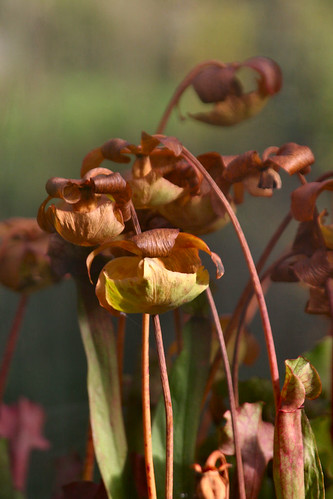 Like all great gardens, it was a very sensual place filled with racous colors, shapes, and textures. Some amazing plants were in bloom - the lithops and the carnivorous pitcher plants in particular, as well as the Nirene Lilys and the always gaudy passion flowers, to say nothing of the usual cast of autumn bloomers like Datura, Salvia Veridis, African Daisies, asters of various sorts, and Solanum. As one might expect, the changing colors of the autumn leaves were quite brilliant in the intense sunlight light; the end of season seedpods and berries were miniature delights of color and intricate shape. Of particular beauty was the Wisteria and Japanese Maple lined alley. The Wisteria had yet to lose it's foliage and the long dangling seedpods looked like chimes hanging from trellises that were punctuated with ivy covered brick columns and brilliant overhead flashes of maroon, scarlet, and orange from the Japanese Maples.
Like all great gardens, it was a very sensual place filled with racous colors, shapes, and textures. Some amazing plants were in bloom - the lithops and the carnivorous pitcher plants in particular, as well as the Nirene Lilys and the always gaudy passion flowers, to say nothing of the usual cast of autumn bloomers like Datura, Salvia Veridis, African Daisies, asters of various sorts, and Solanum. As one might expect, the changing colors of the autumn leaves were quite brilliant in the intense sunlight light; the end of season seedpods and berries were miniature delights of color and intricate shape. Of particular beauty was the Wisteria and Japanese Maple lined alley. The Wisteria had yet to lose it's foliage and the long dangling seedpods looked like chimes hanging from trellises that were punctuated with ivy covered brick columns and brilliant overhead flashes of maroon, scarlet, and orange from the Japanese Maples.
The afternoon was given to touring the old town including the marktplatz, the cathedral and that amazing room, the St. Gallen Abbey Library. Founded by Gallus, one of those amazing, itinerate Irish monks who imposed exile on themselves, the eponymous Abbey was, during the 9th and 10th centuries, one of the lights of western civilization on that side of the alps and the library was it's treasure.
The collection was never sacked or burned, and so contains works beginning with illuminated manuscripts dating from the 9th century and continuing until the present day. I cannot fully describe or even do justice to the feeling of gazing on hand lettered manuscripts, each lovingly decorated with capitals of gold leaf and precious, hand ground pigments. One is, in the presence of the real article, immediately taken with the composed design of each page: letterforms, blocks of text, illustrations, and marginalia all contributing to a unified whole. One wonders if the monks drew rough drafts in sand or dust before laying out and executing the final designs on each sheet of vellum or parchment. Equally amazing to me, and completely unexpected, were the illuminated musical scores - hymns with scores that are, in equal parts, musical notation, lyrics, and linear story lines decorated with saints, sinners, and symbols of belief.
To match such a priceless collection, the library itself is a room that takes one's breath away. The single room containing the collection is astounding - an amazing confection in high baroque style. The two stories of stacks around the perimeter of the room are punctuated by expansive, tall windows, all overarched by a series of allegorical murals painted across the ceiling, each surrounded by heavily carved frames, standing well out from the murals, giving a dimension of depth. Two rows of glass and wood display cases stand in the center of the room, each filled with particularly rare volumes, opened to pages of interest and beauty. The stacks themselves are framed with ornate carving and fronted by a finely made but open wire mesh. Secreted in some of the stacks, nestled on top of books are stuffed local and exotic animals: ferrets, lizards, and the like, each joining the putti and cherubim silenty watching over the precious boards, papers, and inks that make up this tiny gem of a place.
The Abbey cathedral, also executed in the high baroque style, was also nothing short of incredible. In the presence of such grandeur, I tend to go for the details; the gestalt of it is so overwhelming. Of all those details one that caught my eye and keeps returning to memory was a memorial bookstand in the very back of the church, under the organ loft. Shaped like a candelabra, the piece was composed of metal with two huge volumes of Psalms, each propped open facing away from the other. The candelabra sprung upward from between the books, with single huge, clear quartz crystals substituting for candles of wax. The base of the candelabra was anchored by a collection of rounded river cobbles, each a memorial to some beloved soul: some deeply engraved with a name and a date, others with only hand-written inscriptions of ink on stone. It was a beautifully executed piece that seemed somehow oddly personal but no less heartfelt than the other parts of this awe-inspiring place.
Of course, the old town, clustered near the walls of the abbey was full of life: a small farmer's market, a clutch of fountains both large and small, and a dense promenade of people, bustling along or relaxing in front of restaurants, bakeries and sweet shops.
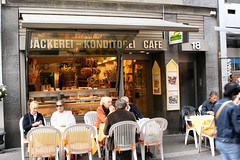
And so it goes while traveling: amazing places seen and photographed, remembered and talked about for long hence. But it's always nice to get home to the comforts of familiar books, music, food, and one's own space.
 Sometimes it seems as if Swiss humor emerges most frequently in the architectural details of their buildings and public places. The brackets supporting the bay windows of the old buildings seems a particularly common place for small surprises and funny faces. One bay window in St. Gallen (left) was particular was loaded: funny faces and figures festooned all the brackets, the corner newels, and the panels. Elsewhere in town,dragons smiled from the end of each drain spout of otherwise dignified buildings.
Sometimes it seems as if Swiss humor emerges most frequently in the architectural details of their buildings and public places. The brackets supporting the bay windows of the old buildings seems a particularly common place for small surprises and funny faces. One bay window in St. Gallen (left) was particular was loaded: funny faces and figures festooned all the brackets, the corner newels, and the panels. Elsewhere in town,dragons smiled from the end of each drain spout of otherwise dignified buildings.  for an open shutter and a frowning one
for an open shutter and a frowning one  on the obverse for a closed shutter. While no bigger than 2 cm. across, each face, after decades of exposure, was still clear and detailed.
on the obverse for a closed shutter. While no bigger than 2 cm. across, each face, after decades of exposure, was still clear and detailed.







